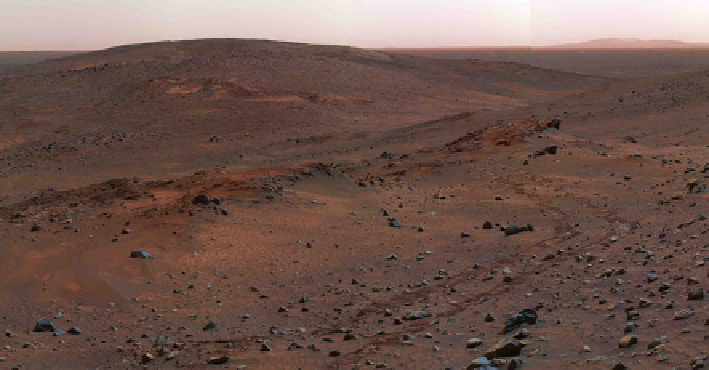Geoscience Reference
In-Depth Information
Fig. 8.2
Picture of Mars, taken by the Spirit rover on Sol 454. One sol is one Martian day.
This image shows a region in the “Columbia Hills” inside Gusev Crater. The view features two
interesting outcrops in the middle distance and “Clark Hill” in the left background. The outcrop
on the right, with rover tracks leading from it, is “Larry's Lookout.” On the left is the Methuselah
outcrop, with apparent layering
(
http://photojournal.jpl.nasa.gov/catalog/PIA07855,OrigCaption
-
NASA/JPL-Caltech/Cornell University, April 20, 2005)
8.2.1
Past Mars
Recent models have shown that even with a dense CO
2
atmosphere, early Mars was,
in fact, colder than Earth. However, transiently warm conditions related to impacts
or volcanism could have produced conditions favoring the formation of the late
Noachian valley networks, even though the mid-late Noachian global conditions
were probably icy. Local warming of the environment by volcanism and impacts
would have been sporadic, but there should have been many events of water flowing
at the surface of Mars. Both the mineralogical and the morphological evidence
indicate a degradation of habitability from the mid-Hesperian onward. The exact
causes are not well understood but may be related to a combination of processes
including loss of early atmosphere, or impact erosion, or both (Westall et al.
2013
).
The loss of the Martian magnetic field strongly affected surface environments
through atmospheric loss and increased radiation; this change significantly degraded
surface habitability (Summons et al.
2011
). When there was a magnetic field, the
atmosphere would have been protected from erosion by solar wind, which would
ensure the maintenance of a dense atmosphere, necessary for liquid water to exist
on the surface of Mars (Dehant et al.
2007
).
The loss of the atmosphere was accompanied by decreasing temperatures. A part
of the liquid water inventory sublimed and was transported to the poles, while the
rest became trapped in a subsurface ice layer.

Search WWH ::

Custom Search